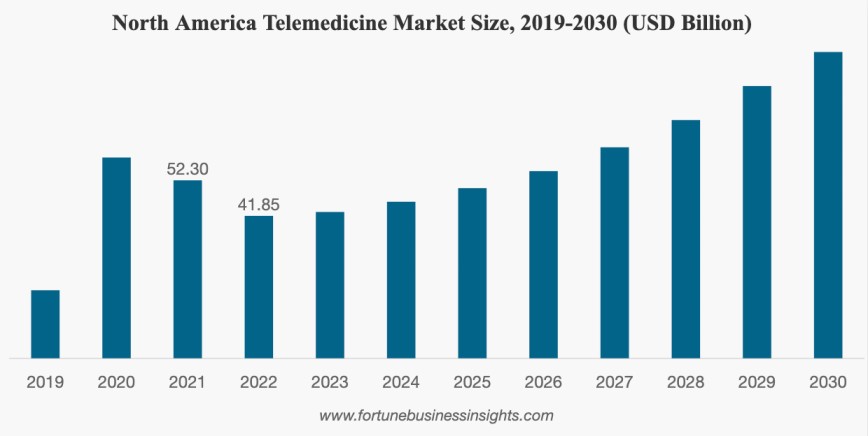Telemedicine has emerged as a pivotal tool in modern healthcare, offering remote medical services via digital platforms. Its scope and importance have surged, driven by advancements in technology, increased internet accessibility, and the need for convenient healthcare solutions.
The COVID-19 pandemic further accelerated the adoption of telemedicine, highlighting its significance in delivering healthcare services while ensuring safety and accessibility. This development encouraged businesses and entrepreneurs to foray into this domain.
We detail for you here the cost to develop a telemedicine app so that entrepreneurs and businesses will know where to start.
Top Telemedicine Apps
In the past decade, the telemedicine sector has witnessed exponential growth, with numerous platforms offering a wide range of medical services remotely. Top telemedicine apps like Teladoc, Amwell, Zocdoc, and Doctor on Demand have revolutionised healthcare delivery by connecting patients with healthcare professionals through virtual consultations, remote monitoring, and prescription services.
These apps have not only transformed the patient experience but also generated substantial revenue, reflecting the growing demand for telemedicine services worldwide.
The Cost To Build A Telemedicine App
To build a pre-built type app the pricing starts at $15,000 onwards depending on the features required. The app can be done in 60 days.
For a custom built app, the development will cost around $25,000 to $250,000 and the app will be ready within 8 to 12 months’ time.
Factors Influencing Development Costs
- Features and Functionalities: The complexity and extent of features directly impact development costs. Basic features like video conferencing, chat, appointment scheduling, and medical history storage are standard. However, additional functionalities such as prescription management, symptom checker, integration with wearables, etc., increase development time and cost.
- Platform Compatibility: Ensuring the app runs seamlessly across various platforms (iOS, Android, web) adds to development costs. Each platform requires specific development and testing efforts to ensure compatibility and performance.
- User Interface and Experience (UI/UX): A well-designed and intuitive UI/UX is crucial for user engagement and satisfaction. Investing in user research, design iterations, and user testing adds to development costs but enhances the app’s usability and adoption rates.
- Integration with Third-Party Services: Integrating APIs for functionalities like payment gateways, electronic health records (EHR), lab results, etc., increases development costs. Compatibility issues, API licensing fees, and maintenance requirements contribute to the overall expenses.
- Compliance and Regulatory Requirements: Compliance with healthcare regulations like HIPAA (for the U.S.), GDPR (for the EU), and other local regulations is mandatory. Implementing security measures, data encryption, and audit trails to ensure patient privacy and data protection adds to development costs.
Technology Stack Selection
- Backend Frameworks: Choices like Node.JS, Python, GoLang, Django, or Ruby on Rails impact development speed, scalability, and maintenance requirements.
- Frontend Frameworks: Options such as React, Angular, or Vue.js affect development efficiency and user interface responsiveness.
- Database Systems: Selection between SQL (e.g., MySQL, PostgreSQL) and NoSQL (e.g., MongoDB, Cassandra, REDIS, Elasticsearch) databases depends on data structure and scalability requirements.
- Mobile Apps – For iOS Swift and For Android Java / Kotlin
- For Video Calls – WebRTC (Isometrik)
- Hosting and Cloud Services: Cloud platforms like AWS, Google Cloud, or Microsoft Azure offer scalability, reliability, and security but entail ongoing hosting costs.
- Security Protocols and Measures: Implementing HTTPS, encryption, two-factor authentication, and regular security updates incur additional expenses but are essential for safeguarding patient data.

Ways To Monetise A Telemedicine App
- Commission from Doctors.
- Commission from Clinic.
- Commission from Pharmacy Store.
- Commission from Vendors Pharmacy.
- Listing on a website.
Development Team Composition
- Project Manager: Oversees project planning, resource allocation, and ensures timely delivery within budget.
- UI/UX Designer: Designs user interfaces, wireframes, and prototypes to enhance user experience and engagement.
- Frontend and Backend Developers: Frontend developers handle client-side development, while backend developers manage server-side logic, databases, and APIs.
- Quality Assurance (QA) Engineers: Test the app for functionality, performance, security, and compatibility to identify and rectify defects.
- Database Administrators (DBAs): Manage data storage, retrieval, and ensure database integrity and security.
- Security Experts: Implement security protocols, encryption, access controls, and conduct regular audits to protect sensitive patient information.
Additional Costs to Consider
Maintenance and Support
- Bug Fixes and Updates: Regular maintenance involves identifying and fixing bugs, enhancing features, and ensuring compatibility with new OS versions.
- Server Maintenance: Ensuring server uptime, scaling resources, and addressing performance issues to accommodate growing user traffic.
- Technical Support: Aiding users, addressing queries, and troubleshooting issues to ensure smooth functioning of the app.
Compliance and Certification
- HIPAA Compliance (for U.S.): Implementing measures to secure protected health information (PHI) and adhering to HIPAA regulations to protect patient privacy.
- GDPR Compliance (for EU): Ensuring the app handles user data responsibly, obtaining user consent, and providing data transparency as per GDPR regulations.
- Other Regulatory Requirements: Complying with local healthcare regulations, data protection laws, and industry standards relevant to the app’s target markets.
Strategies to Optimise Development Costs
Minimum Viable Product (MVP) Approach
- Identifying Core Features: Prioritising essential features that address users’ primary needs and deliver value.
- Iterative Development: Releasing incremental updates based on user feedback and market response to refine and improve the app over time.
- Gathering User Feedback: Actively seeking input from users to understand their preferences, pain points, and expectations, guiding future development efforts.
Outsourcing vs. In-house Development
- Pros and Cons: The cost to develop a telemedicine app depends on how to develop it. Outsourcing offers cost savings, access to specialised talent, and faster time-to-market but may involve communication challenges and quality control issues. In-house development provides greater control and alignment with business objectives but can be more expensive and time-consuming.
- Finding the Right Development Partner: The cost to develop a telemedicine app depends on your development partner too. Conducting thorough research, evaluating expertise, portfolio, and client reviews to select a reliable and competent development partner aligned with project requirements and budget.
Open-Source Solutions and APIs
- Leveraging Existing Technologies: Utilising open-source frameworks, libraries, and APIs can reduce development time and costs by eliminating the need to build functionalities from scratch.
- Customisation vs. Off-the-shelf Solutions: Balancing between customisation needs and cost-effectiveness by leveraging pre-built solutions for non-core functionalities while customising critical components to meet specific requirements and enhance user experience.
Budgeting and Planning
Allocating Resources Strategically: Proper budgeting and resource allocation are crucial for the successful development of a telemedicine app. Allocating resources strategically ensures that the app meets quality standards while staying within budget constraints.
Continuous Improvement and Adaptation: The telemedicine landscape is constantly evolving, driven by technological advancements, and changing consumer needs. Therefore, it’s essential to adopt a mindset of continuous improvement and adaptation.
Regularly gathering user feedback, monitoring industry trends, and implementing updates to enhance functionality and user experience are critical for the long-term success of a telemedicine app.
Long-term Vision and Sustainability
Scalability and Growth Opportunities: A telemedicine app with a long-term vision should be designed for scalability and growth. As the user base expands and technology evolves, the app should be capable of accommodating increasing demand and integrating new features seamlessly. Scalability ensures that the app remains relevant and competitive in a dynamic healthcare landscape.
Prioritising User Experience and Security: User experience and security are paramount in telemedicine app development. Prioritising intuitive design, seamless navigation, and personalised features enhances user satisfaction and engagement. Moreover, implementing robust security measures, encryption protocols, and compliance standards (such as HIPAA and GDPR) instils trust among users and safeguards sensitive medical data.
Conclusion: Cost To Develop A Telemedicine App
In conclusion, the cost to develop a telemedicine app is influenced by various factors, including the scope of features, technology stack, compliance requirements, and long-term sustainability goals. By prioritizing budgeting and planning, allocating resources strategically, and embracing a long-term vision focused on scalability, growth, user experience, and security, businesses can develop a cost-effective and impactful telemedicine solution that meets the evolving needs of patients and healthcare providers alike.
Embrace the future of healthcare delivery with the Telemedicine software solution provided by us. Whether you’re a healthcare provider seeking to enhance patient care or an entrepreneur looking to capitalise on emerging market trends, our telemedicine software solution offers the perfect platform to realise your vision and revolutionise the way healthcare services are accessed and delivered.

After an Engineering degree and a Diploma in Management I devoted 16+ years working in the automotive industry. My innate skill and extreme passion in writing, encouraged me to adopt it up as a profession. I have been writing for more than 10+ years in the software industry. The 400+ blogs I published are informative, exhaustive and interesting to a professional and causal reader.










Your blog is very nice.